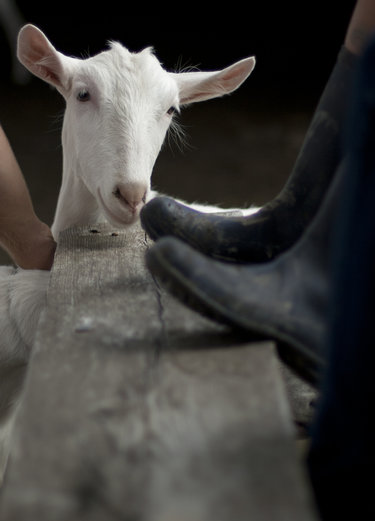Meet the Animals at the Altamont Fair
ALTAMONT —Though the Altamont Fair has long been a place to showcase agricultural achievements, more and more it’s also where people share their intimate connections to the living world with others.
The tri-county fair will be open for its 120th year from Aug. 8 to 13 at its grounds in the village of Altamont. Coordinators have been making a concerted effort in recent years to promote environmental and agricultural education, in tribute to the event’s core values and historical roots.
Last year, planners designated a “Green” theme and this year they are hoping to encourage more first-person interactions among animals, farmers, and visitors through such events as “Meet the Animals,” which features demonstrations under the Agricultural Tent.
Like nearly all other rural fairs, the Altamont Fair was founded on the idea of promoting and encouraging better agriculture. Fairs offered local farmers a prestigious community event to show off their best crops, stock, and equipment.
The Capital Region in 1893, when the first Altamont Fair was held, was a community familiar with, and rooted in, agricultural. Nationwide at the time, far more people lived in rural settings than in cities.
“We can go out and hire more entertainment but we don’t need to be Great Escape; we can’t. We need to keep in mind is we’re still an agricultural fair,” said Marie McMillen, the fair’s manager. She explained that one of the Altamont Fair’s first buildings, constructed in 1893, was the Fine Arts and Applied Science Building. At the time, farmers used the building to showcase their best producing cows and livestock, their newest developed seed varieties and the fruits of their harvest.
They compared wooden tools and equipment to the newer, more expensive, steel ones. The building still stands and will be showcasing agricultural events this year.
Though these agricultural traditions have remained a steady part of the fair over the decades, a lot of other things have changed. To newer generations, the fair has different meaning.
Most Americans now live in cities or suburbs, and many people have limited access and knowledge about daily farming practices and animals, far less than their historical predecessors. Some rural growers worry this lack of modern knowledge may lead to a lack of appreciation or understanding of how farming works.
“For a number of reasons, people’s impressions of farming may be skewed. Some might think the animals are mistreated but it’s anything but the truth. Farmers are stewards of animals,” said Altamont Fair board director, Tom Della Rocco. “Farmers know that happy stock— well cared for stock, will be healthier, easier to handle, and they produce more.”
“Only about two percent of today’s population live on farms,” said Della Rocco. “A lot of Americans that don't have animals don’t know how they’re maintained and cared for, but everybody who eats eggs or drinks milk is connected to it.”
In modern context fairs have become a place where many people are introduced to agriculture and to animals and those who care for them.
Some of the Meet the Animals programming includes: poultry housing, dog agility shows, Goat Promotion, Guess the Animal Weights, The Buzz About Bees, Best Fleece on a Hoof, Learn to Milk a Goat, Veggie Races, Crowing Contests, Meet the Oxen, and Meet the Alpacas.
The Agricultural Tent will have demonstrations from 12:30 to at least 6 p.m., most days, with new and different shows occurring every half or full hour.
“When polled, I think the most common reason families gave for going to the fair was to “see the animals,” said Della Rocco.
Many of the shows involve demonstrations with interesting facts and have animals present for the visitors to meet. “We started the event a few years ago as an Ag awareness tent. Now as Meet the Animals, it has proved very popular,” said Della Rocco.
One of the fair’s most popular agricultural events, Guess the Animal Weights will take place beneath the tent, said McMillen. “People and kids just love it; it’s a lot of fun,” she said.
“There are all kinds of animals, from pigs to horses; there’s a bunch of different livestock variety. It’s hard for some to imagine. We get people guessing the three-pound rooster weighs 15 pounds,” recalled Della Rocco.
Della Rocco has been coming to the fair since he was a kid and performs The Buzz About Bees show. He’s kept bees since he was a teenager, picking up the hobby from his grandfather. “As a bee keeper, basically, I try to provide the visitors with a little bit of information and how important the honey bee is for agriculture– they pollinate 25 percent of all plants we use for agriculture. We also get honey and beeswax from them,” said Della Rocco. “You talk about how many bees live in a hive and all different aspects of honey bees, how they are beneficial to agriculture, and everything like that. It’s a fascinating thing.”
Though visitors can’t put their hands on the bees, they can examine their hives and the equipment beekeepers use. Della Rocco used to bring a glass container of bees to the show, but high temperatures in recent years have made the display deadly to the insects.
Though Della Rocco’s presentation may focus on bees, he said other demonstration would involve cows, horses, sheep, rabbits, chickens, hogs, and other animals and would be presented by people very enthusiastic about their animals. “A lot of these programs give a visitor a first experience, a first-hand knowledge not only with the animal but how they are cared for,” said Della Rocco.
